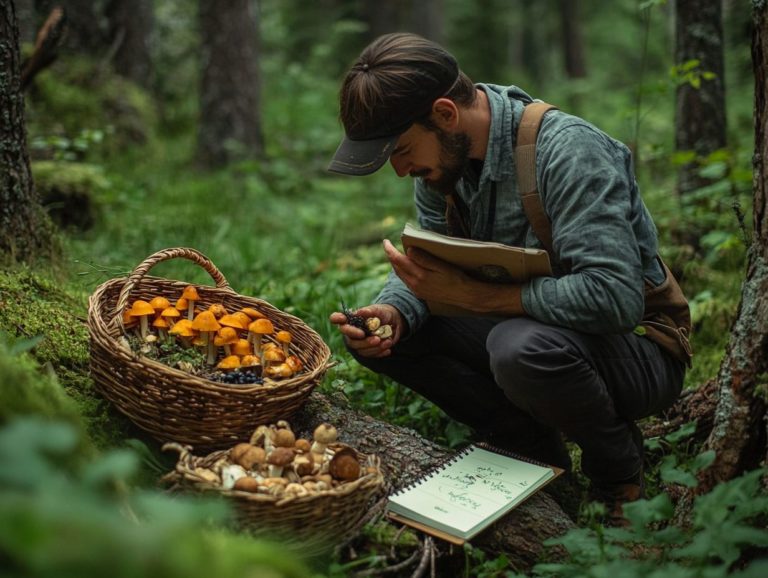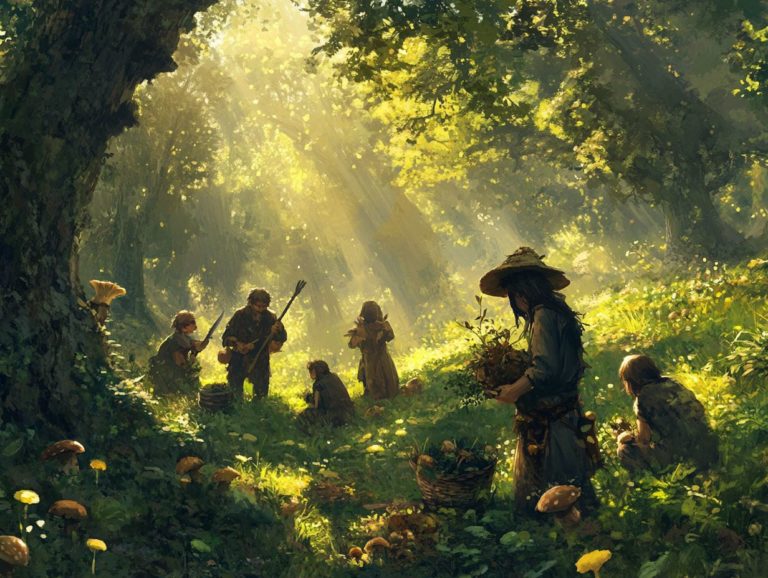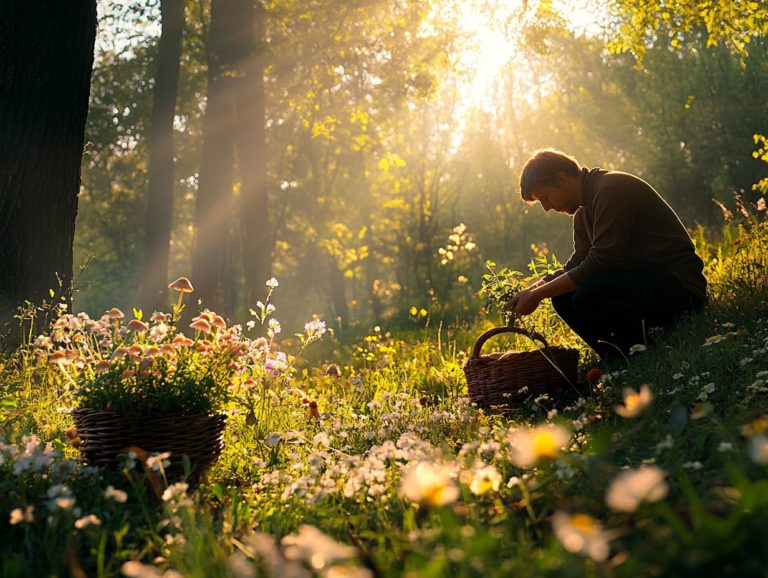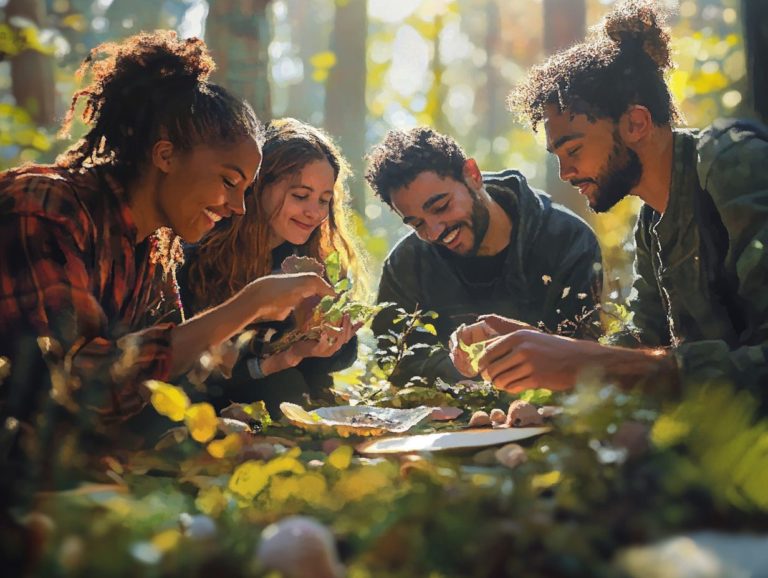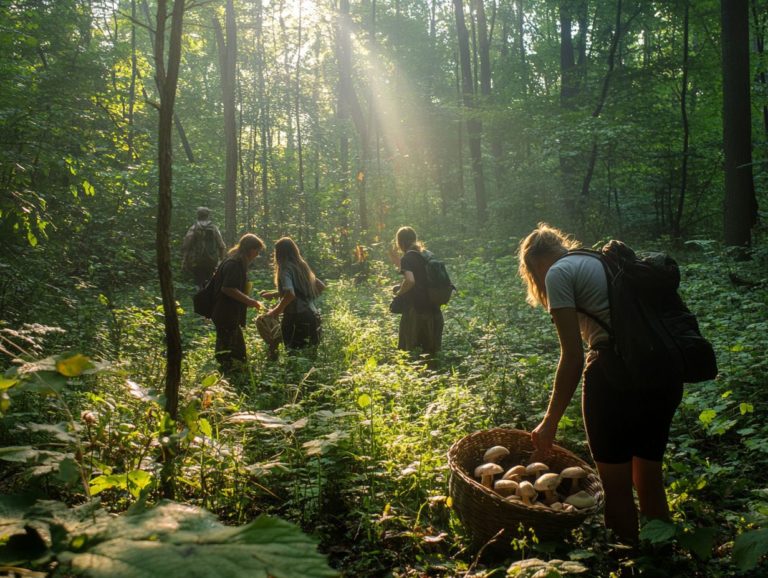DIY Foraging: Creating Your Own Techniques
Get ready to explore the world of DIY foraging! This guide invites you to discover the joy and benefits of seeking out wild, edible plants, while deepening your connection to nature and enriching your diet.
You’ll uncover the essential tools you need and learn how to identify common edible plants. You will also refine your harvesting techniques. With safety tips at your disposal, you can embark on this journey with confidence. Delectable recipes will help you savor the fruits of your labor.
Dive into the adventure of foraging and revel in the abundant offerings of nature!
Contents
Key Takeaways:
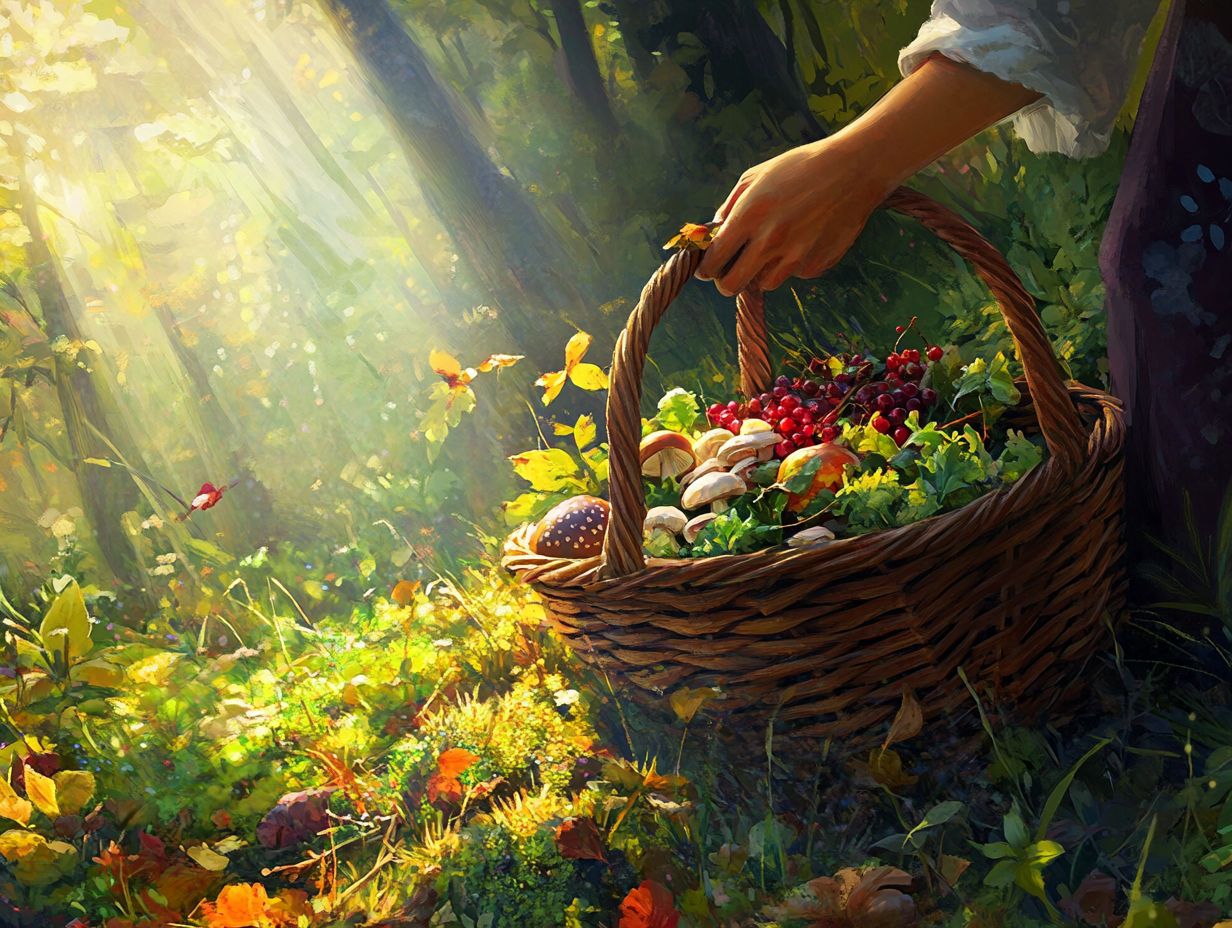
- Discover the environmental and health benefits of DIY foraging, such as reducing food waste and increasing physical activity.
- Learn the essential tools and equipment needed to get started, including foraging baskets and field guides.
- Stay safe while foraging by following precautions and tips. Try out some delicious and nutritious recipes using foraged ingredients.
What is DIY Foraging?
DIY foraging allows you to gather edible treasures from nature. It includes a delightful range of wild foods, like herbs, mushrooms, and local plants. By mastering the art of wild foraging techniques, this hands-on journey sharpens your survival skills and deepens your connection with nature while boosting your diet.
In a world leaning towards sustainable living, DIY foraging is an appealing way to embrace nature’s offerings. Take mushroom hunting, for example; it’s not just about unearthing earthy flavors but also about practicing foraging techniques in cooking and practicing mindful harvesting methods.
You ll find wild herbs like dandelion and nettles that often go unnoticed but are brimming with health benefits. As you master the art of identifying these edibles, you cultivate a profound appreciation for your surroundings.
This journey fosters a way of living that honors the environment and champions food diversity.
Benefits of DIY Foraging
The benefits of DIY foraging are rich and varied. They span health, environmental, and social dimensions, collectively cultivating a self-sustaining lifestyle, as highlighted in the growing popularity of foraging techniques.
By foraging for wild edibles, you gain access to a diverse array of nutritional compounds that may be overlooked in conventional food sources. This practice fosters a deeper connection to your local ecosystem and sharpens your survival skills, bringing you closer to nature’s rhythms.
Environmental and Health Benefits
The environmental and health benefits of DIY foraging are extraordinary. By embracing sustainable harvesting practices, you tap into local wild foods bursting with nutritional value and deepen your connection to the ecosystem.
As you engage with your surroundings, you develop a richer understanding of nature and create lasting bonds with the environment.
Foraging opens the door to a treasure trove of nutrient-dense plants and fungi, each with remarkable medicinal properties that enhance your overall wellness.
Many wild foods are packed with antioxidants, vitamins, and minerals that often outshine their cultivated counterparts. This practice supports biodiversity by championing the conservation of native habitats.
By employing sustainable gathering techniques, you can significantly reduce your ecological footprint while energizing local communities. This effort cultivates a shared appreciation for the natural resources around you.
Ultimately, this harmonious relationship promotes healthier lifestyles through improved nutrition and fosters a sense of stewardship towards the land we all share.
Getting Started with DIY Foraging
Embarking on your DIY foraging journey invites you to develop a love for learning and a deep passion for exploring nature. By following foraging techniques for beginners, this enriching experience is accessible to anyone curious about local plants and wild edibles.
Connect with foraging groups or enroll in immersive training sessions to gain invaluable resources. These will refine your identification skills and equip you with techniques necessary for gathering edible resources safely and sustainably.
Start your foraging adventure today, and discover the incredible bounty nature has to offer!
Essential Tools and Equipment
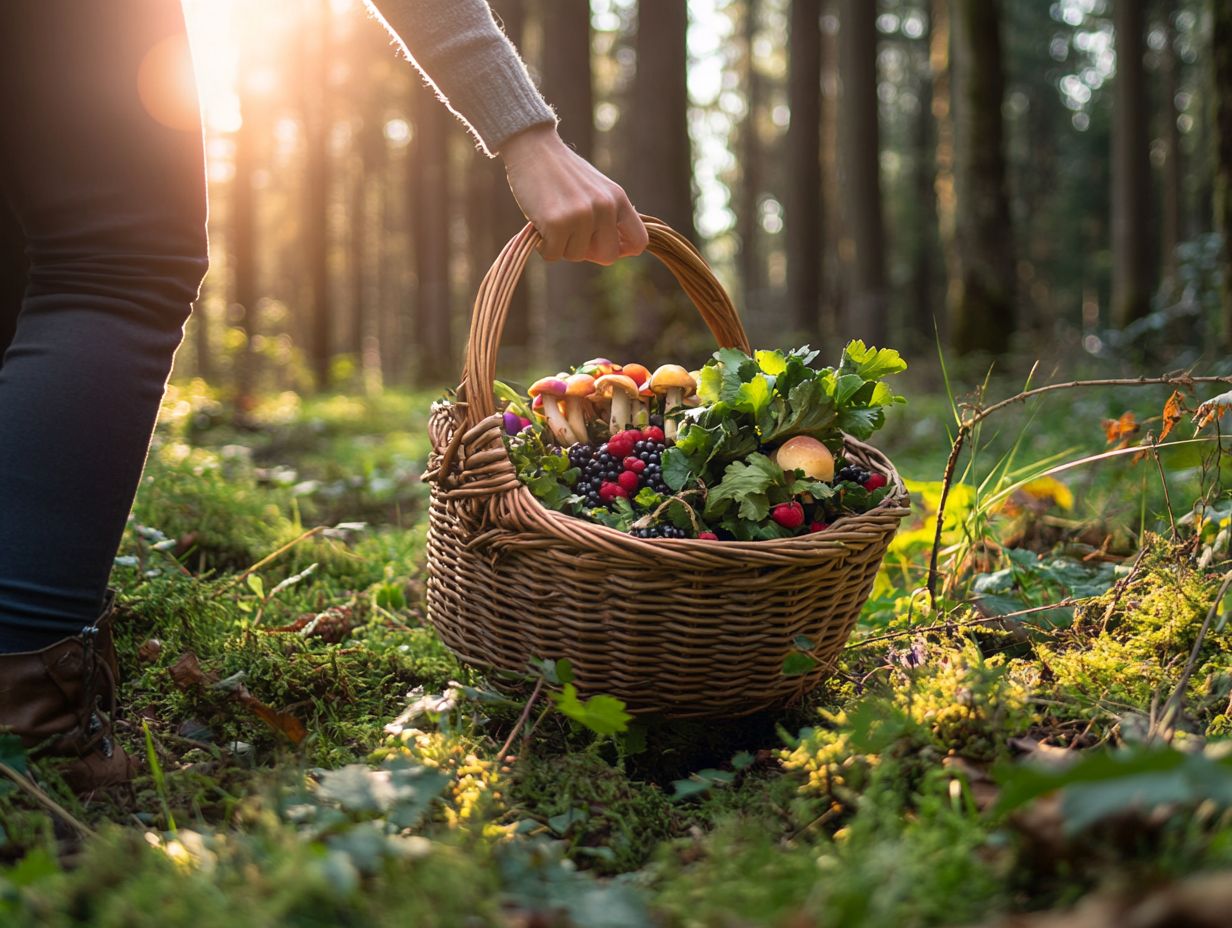
Essential tools and equipment for your DIY foraging adventures include:
- Baskets for harvesting
- Knives for cutting
- A reliable field guide to identify safe edibles
- Cleaning and storage tools to preserve flavor and nutritional value
Equipping yourself with a sturdy pair of gloves is a must for protection against prickly or potentially harmful plants. A first aid kit is invaluable for immediate care in case of minor mishaps during your expeditions. You ll also need a portable water bottle to stay hydrated and clean your discoveries when running water isn t available.
Safety equipment, like a whistle and a map, helps enhance navigation and ensures you find your way back in unfamiliar surroundings. These tools are your best allies on this exciting journey!
Identifying Edible Plants
Identifying edible plants is an essential skill in DIY foraging, ensuring both safety and success as you harvest local flora. Use different resources, such as field guides and community learning opportunities, to refine your identification skills.
With dedication, you’ll gain the confidence to distinguish between the bounty of edible plants and the potentially harmful species nearby.
Common Edible Plants and How to Find Them
Common edible plants, such as dandelions, raspberry bushes, and various herbs, are plentiful in diverse environments, making them easily accessible for you as an aspiring forager. By understanding their habitats and honing your identification skills, you ll discover these wild edibles quickly and appreciate their culinary benefits.
These plants thrive in a range of settings, from urban gardens to untamed wilderness. Knowing where to look can significantly boost your foraging success. For example, dandelions often bask in sunny, disturbed areas, while raspberry bushes favor sheltered spots along woodland edges.
Mastering effective identification techniques like examining leaf shapes, flower colors, and growth patterns is essential for distinguishing between similar species. By familiarizing yourself with these varieties, you enhance your culinary repertoire with salads, teas, or jams, fostering a sustainable bond with nature and nurturing your appreciation for local biodiversity.
Foraging Techniques
Foraging techniques involve methods crucial for successfully harvesting, cleaning, and storing wild foods, and you can learn how to innovate traditional foraging techniques while embracing sustainable practices.
Mastering these techniques enhances your yield while respecting the delicate balance of the environment, positively contributing to the health of wild plant communities.
Harvesting, Cleaning, and Storing Edible Plants
Harvesting, cleaning, and storing plants demand careful attention to detail and specific techniques to preserve the quality and safety of wild foods. By employing the right harvesting methods and cleaning practices, you can elevate your culinary experience, ensuring food safety and maximizing the nutritional value of your foraged ingredients.
When you cut herbs or greens, using sharp, clean tools prevents damage to the plant and encourages healthy regrowth. After harvesting, gently rinse the plants in cold water to wash away dirt and potential contaminants. Prioritizing safety is crucial, so know how to properly identify plants to avoid toxic varieties.
Once cleaned, store these treasures in breathable bags or containers in a cool, dark place to keep them fresh for longer. The culinary possibilities are vast; envision fresh salads, savory stews, or herbal infusions that showcase the unique flavors of nature s bounty.
Safety Considerations
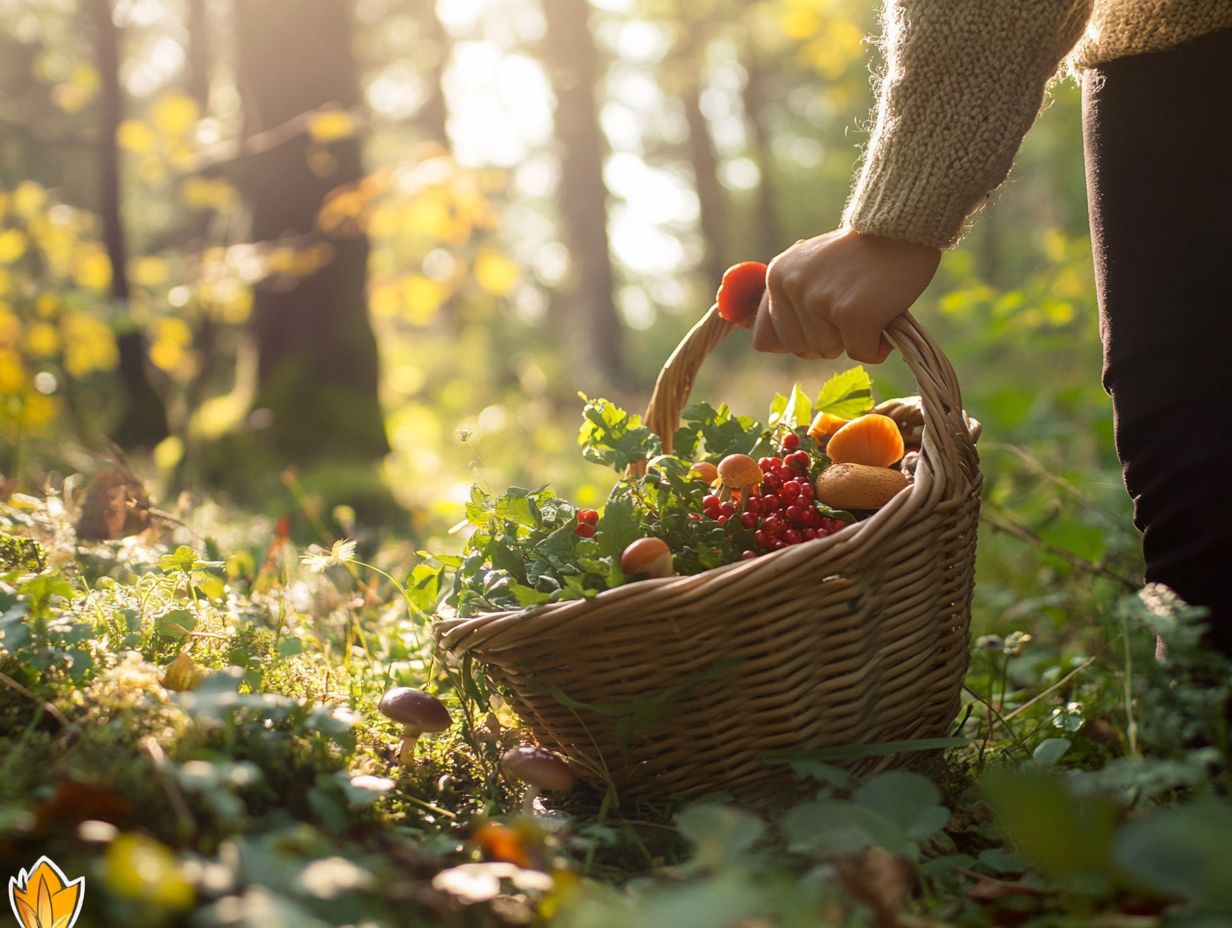
Safety should be your top priority when diving into DIY foraging. Taking the right precautions can help you avoid potential hazards linked to gathering wild edibles. It’s essential to be well-versed in food safety practices and improve your identification skills.
This knowledge will empower you to safely enjoy your harvest, minimizing the risk of accidentally consuming harmful species especially important in emergency situations.
Precautions and Tips for Safe Foraging
Precautions and tips for safe foraging involve improving your ability to recognize plants, leveraging community resources, and seeking mentorship from seasoned foragers. This approach minimizes risks and enhances your overall experience.
Adhering to food safety guidelines is essential. It enables you to enjoy the rewards of wild edibles while steering clear of potential hazards.
To start pinpointing safe species, dive into thorough research. Reputable field guides and mobile apps tailored for foragers can be your best allies. Joining local foraging groups or workshops offers invaluable insights.
By learning from seasoned experts who are well-acquainted with the terrain and its native flora, you can enhance your skills effectively.
Being familiar with local regulations is crucial for ensuring compliance with harvesting practices, ultimately preserving both the ecosystem and your safety. Keeping an eye on the environment can also help you identify risks.
Watch out for contamination from nearby roads or pollutants. By being diligent, you can venture into the wild and confidently harvest delicious and nutritious plants.
DIY Foraging Recipes
You can create mouthwatering dishes from foraged ingredients that will wow your taste buds! These wild foods are brimming with rich flavor profiles and nutritional value. By exploring various cooking methods, you can transform your foraged treasures into delectable and nourishing dishes that truly celebrate nature s bounty.
Delicious and Nutritious Dishes Using Foraged Ingredients
Delicious and nutritious dishes crafted from foraged ingredients can elevate your meals, highlighting the unique flavors and nutritional benefits that nature has to offer. Imagine savoring savory mushroom dishes or refreshing salads infused with wild herbs these recipes invite you to embark on a culinary adventure!
For instance, consider a delightful wild mushroom risotto featuring foraged varieties like porcini or chanterelles. It not only delivers rich, earthy notes but also supplies a remarkable dose of B vitamins and minerals essential for energizing your day.
Alternatively, picture a vibrant salad made with dandelion greens, wild garlic, and seasonal edible flowers. This dish not only pleases the eye but is also brimming with antioxidants and vitamin C, promoting your overall health.
By embracing these wild ingredients, you re not just enhancing flavor; you re cultivating a deeper appreciation for nature s bounty and encouraging more sustainable cooking practices.
Frequently Asked Questions
What is DIY foraging?
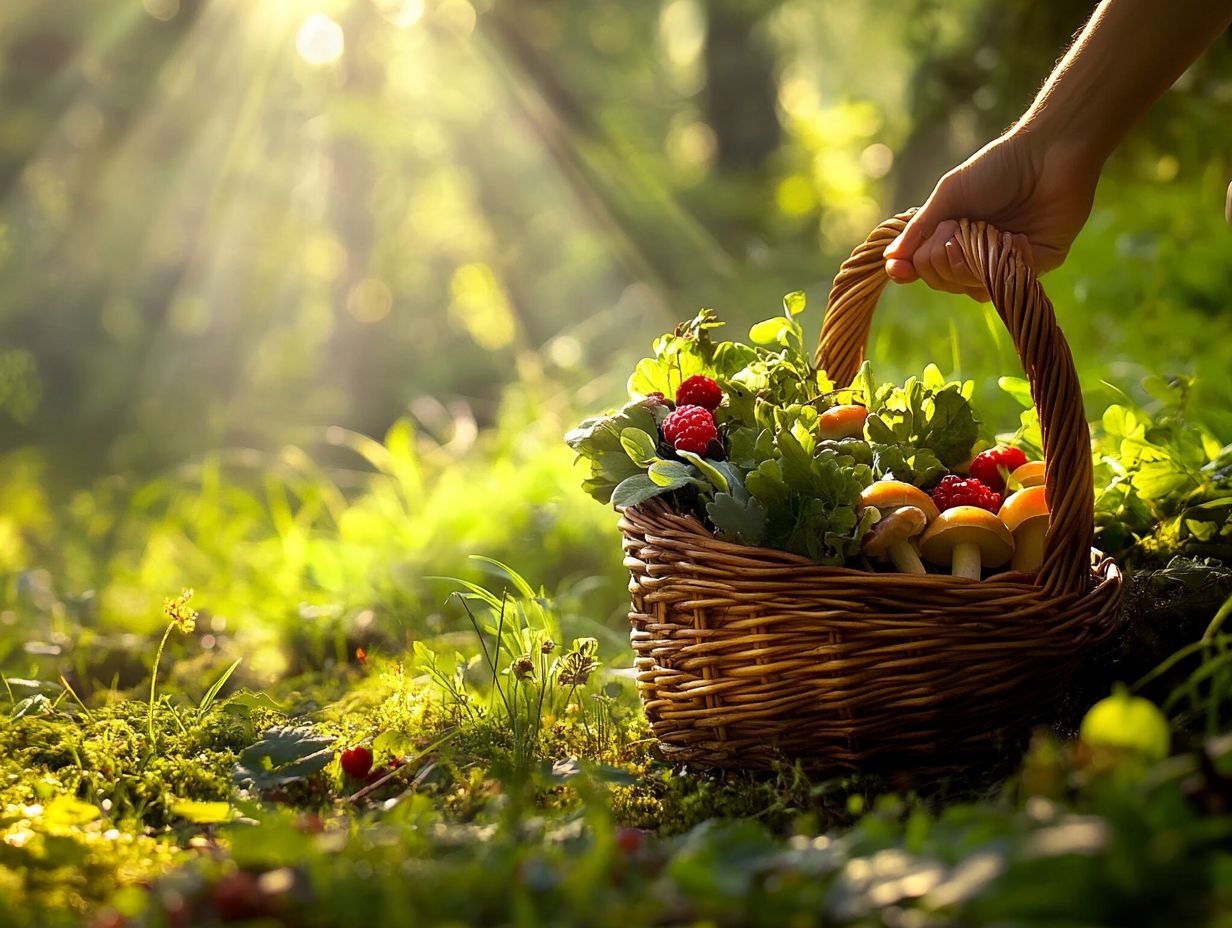
DIY foraging involves developing your own foraging techniques for finding and collecting wild edible plants and mushrooms.
Why is it important to create your own foraging techniques?
Creating your own foraging techniques allows you to tailor your methods to your specific needs and preferences, making the experience more enjoyable and efficient. To learn more about this, check out how to innovate your foraging techniques.
Do I need any special skills to create my own foraging techniques?
No, anyone can create their own foraging techniques. All you need is a basic understanding of foraging and a willingness to experiment and learn along the way, as outlined in the art of foraging.
What are some benefits of DIY foraging?
DIY foraging allows you to be more self-sufficient and connected to nature, as well as potentially saving money by not having to purchase wild edible plants and mushrooms from stores. Learning foraging techniques for outdoor enthusiasts can enhance your experience in the wild.
Are there any risks associated with creating your own foraging techniques?
Yes, it is important to research and properly identify any plants and mushrooms before consuming them. Always double-check before you eat! You should also be aware of any potential environmental hazards in the area you are foraging in.
How can I get started with DIY foraging?
Start your adventure by researching wild edible plants and mushrooms in your area!
Then, dive in and try different ways to gather food from nature. You ll be amazed at what you find!

